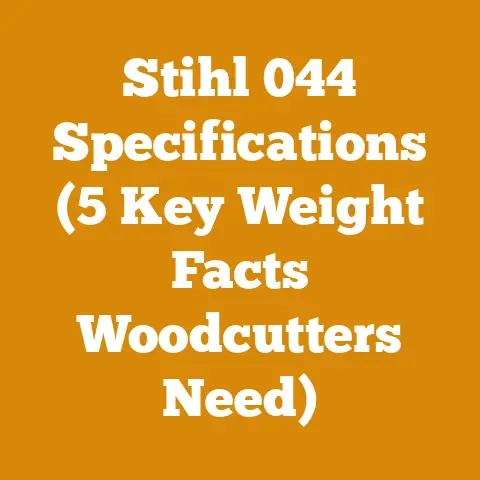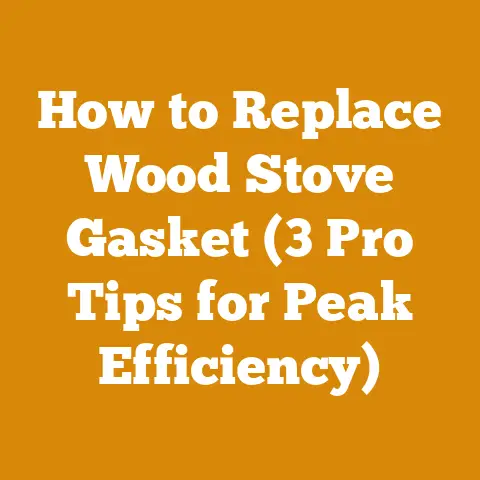Can a Wood Stove Pipe Be Horizontal? (5 Expert Tips)
Imagine this: It’s a frigid winter evening, the wind is howling, and you’re dreaming of the cozy warmth radiating from your wood stove.
You’ve meticulously stacked your seasoned firewood, the kind that crackles just right.
But then, a nagging question pops into your head: “Can my wood stove pipe be horizontal?” It’s a question that could mean the difference between a safe, efficient heating experience and a smoky, potentially dangerous disaster.
As someone who’s spent years in the wood processing and firewood preparation industry, I’ve seen firsthand the consequences of improper stove pipe installation.
That’s why I want to share my expert tips to help you navigate this crucial aspect of wood stove ownership.
Understanding Wood Stove Pipe Orientation: The Fundamentals
Before diving into the specifics of horizontal stove pipes, let’s establish some fundamental concepts.
Think of your wood stove as an engine and the stove pipe as its exhaust system.
Just like a car needs a clear exhaust path to run efficiently, your wood stove relies on proper drafting to function correctly.
Draft: Draft is the upward flow of air through the stove and chimney, carrying smoke and combustion gases away from your home.
A strong draft ensures efficient burning and prevents smoke from backing up into your living space.Creosote: This is a dark, oily, flammable substance that accumulates inside stove pipes and chimneys as a byproduct of incomplete combustion.
Excessive creosote buildup is a serious fire hazard.Green Wood vs.
Seasoned Wood: Green wood has a high moisture content, making it difficult to burn efficiently and increasing creosote production.
Seasoned wood, on the other hand, has been properly dried (typically for 6-12 months) and burns cleaner and hotter.
I always recommend investing in a moisture meter to ensure your firewood is below 20% moisture content.
I’ve found the General Tools MMD4E to be reliable and affordable.Single-Wall vs.
Double-Wall Stove Pipe: Single-wall pipe is typically used for the connector pipe that runs from the stove to the wall or ceiling.
Double-wall pipe, with its insulating air gap, is often preferred for chimney systems as it helps maintain higher flue temperatures, improving draft and reducing creosote formation.
Can a Wood Stove Pipe Be Horizontal? The Short Answer
The simple answer is: yes, a wood stove pipe can be horizontal, but it’s generally not recommended and should only be done in specific circumstances with careful planning and execution.
The ideal setup is a straight, vertical chimney system.
However, architectural constraints or existing fireplace setups sometimes necessitate horizontal runs.
5 Expert Tips for Handling Horizontal Wood Stove Pipes
If you find yourself in a situation where a horizontal run is unavoidable, here are five expert tips to minimize risks and maximize efficiency:
1. Minimize the Horizontal Run Length
The most crucial factor is to keep the horizontal section as short as possible.
Think of it this way: smoke naturally wants to rise.
Every foot of horizontal pipe adds resistance to the draft, increasing the likelihood of smoke spillage and creosote buildup.
Rule of Thumb: I aim for a maximum horizontal run of no more than 75% of the vertical height of the chimney.
For example, if your chimney is 12 feet tall, the horizontal run should ideally be no more than 9 feet.
This is a maximum – shorter is always better.Case Study: I once consulted on a project where the homeowner insisted on a 15-foot horizontal run to connect his wood stove to an existing chimney.
After explaining the potential issues and demonstrating how the extended horizontal section significantly hampered the draft, we were able to reconfigure the stove placement and reduce the horizontal run to just 6 feet.
The difference in stove performance was remarkable.Measurement is Key: Before starting any installation, accurately measure the distance from the stove outlet to the chimney connection point.
Consider alternative stove locations or chimney modifications to minimize the horizontal distance.
2. Maintain a Consistent Upward Slope
A horizontal pipe isn’t truly horizontal; it should have a slight upward slope towards the chimney.
This helps gravity assist the upward flow of smoke and minimizes creosote accumulation.
Slope Specification: I recommend a minimum slope of ¼ inch per foot of horizontal run.
This means that for every foot of horizontal pipe, the end connected to the chimney should be ¼ inch higher than the end connected to the stove.Tools of the Trade: Use a level and a ruler to accurately measure and maintain the slope during installation.
I find a laser level particularly helpful for longer runs.Practical Example: Imagine a 6-foot horizontal run.
The chimney end should be 1.5 inches higher than the stove end (6 feet x ¼ inch/foot = 1.5 inches).
3. Use Double-Wall Stove Pipe for Horizontal Sections
Double-wall stove pipe offers several advantages over single-wall pipe, especially in horizontal runs.
- Improved Draft: The insulation provided by the double-wall construction helps maintain higher flue temperatures, which promotes a stronger draft.
- Reduced Creosote: Higher flue temperatures also reduce condensation and creosote formation.
-
Increased Safety: Double-wall pipe reduces the risk of accidental burns from contact with the hot surface.
-
Cost Considerations: Double-wall pipe is more expensive than single-wall pipe, but the benefits in terms of safety and performance are well worth the investment, especially for horizontal runs.
Material Specifications: When selecting double-wall pipe, ensure it’s UL listed and meets the relevant safety standards in your region.
Look for pipes with a stainless steel inner liner for improved durability and corrosion resistance.
4. Install a Cleanout Tee
A cleanout tee is a crucial component in any stove pipe system, but it’s especially important when dealing with horizontal runs.
It provides easy access for cleaning out creosote and other debris that may accumulate in the pipe.
Placement: Install the cleanout tee at the lowest point of the horizontal run, near the stove connection.
This allows gravity to assist in the removal of creosote.Maintenance: Regularly inspect and clean the cleanout tee, especially during the heating season.
I recommend cleaning it at least once a month, or more frequently if you burn a lot of wood or use wood that isn’t fully seasoned.Tools for Cleaning: A chimney brush and scraper are essential tools for cleaning stove pipes.
I prefer a flexible fiberglass brush for navigating bends and corners.Personal Experience: I once neglected to clean the cleanout tee on my own stove for several months.
When I finally opened it up, I was shocked to find a significant accumulation of creosote.
This experience reinforced the importance of regular maintenance.
5. Ensure Proper Chimney Height and Termination
The height and termination of your chimney play a critical role in draft performance, especially when a horizontal run is involved.
Minimum Height: The chimney should extend at least 3 feet above the highest point where it exits the roof and at least 2 feet higher than any part of the building within a 10-foot radius.
This helps prevent downdrafts and ensures adequate draft.Chimney Cap: A chimney cap protects the chimney from rain, snow, and debris, and it can also help prevent downdrafts.
Choose a cap that is appropriately sized for your chimney and designed for your specific climate.-
Location, Location, Location: Avoid placing the chimney near trees, tall buildings, or other obstructions that could interfere with the draft.
-
Technical Data: Consult your local building codes and regulations for specific chimney height and termination requirements.
Bonus Tips for Optimal Performance
Beyond the five key tips, here are some additional considerations for maximizing the performance and safety of your wood stove with a horizontal pipe:
Burn Seasoned Wood: I cannot stress this enough.
Burning seasoned wood is crucial for efficient combustion, reduced creosote production, and a stronger draft.
Invest the time and effort to properly season your firewood.
I aim for a moisture content below 20%.Proper Airflow: Ensure your wood stove has adequate airflow.
A properly sized air intake is essential for efficient combustion.
Adjust the air controls on your stove to achieve a clean, hot burn.Regular Inspections: Schedule regular professional chimney inspections, at least once a year, to identify potential problems and ensure your system is operating safely.
A certified chimney sweep can assess the condition of your chimney, clean it thoroughly, and make recommendations for repairs or improvements.Creosote Monitoring: Keep an eye on creosote buildup.
If you notice excessive creosote accumulation, it’s a sign that your stove isn’t burning efficiently or that your wood isn’t properly seasoned.Consider a Barometric Damper: In some cases, a barometric damper can help regulate draft and prevent over-firing.
However, these should be installed by a professional.
Choosing the Right Tools for the Job
Proper tools are essential for a safe and efficient wood stove installation.
Here’s a list of my go-to tools:
Measuring Tape: A good quality measuring tape is essential for accurate measurements.
I prefer a tape measure with a magnetic tip for easier use.Level: A level is crucial for ensuring a proper slope on the horizontal pipe.
A laser level can be particularly helpful for longer runs.-
Drill: A drill is needed for installing stove pipe supports and connecting the pipe sections.
-
Screwdrivers: A variety of screwdrivers is essential for tightening screws and bolts.
-
Pliers: Pliers are useful for gripping and manipulating stove pipe sections.
Chimney Brush: A chimney brush is essential for cleaning stove pipes and chimneys.
Choose a brush that is appropriately sized for your chimney and made of durable materials.-
Scraper: A scraper is useful for removing stubborn creosote deposits.
-
Safety Glasses: Safety glasses are essential for protecting your eyes from debris.
-
Gloves: Gloves protect your hands from cuts and burns.
-
Ladder: A sturdy ladder is necessary for accessing the chimney.
Wood Selection and Preparation: The Foundation of Efficient Burning
The type and quality of wood you burn have a significant impact on stove performance and creosote production.
Hardwoods vs.
Softwoods: Hardwoods, such as oak, maple, and ash, are denser and burn longer and hotter than softwoods, such as pine and fir.
Hardwoods also tend to produce less creosote.Seasoning Process: Properly seasoning firewood is crucial for reducing moisture content and improving burning efficiency.
The seasoning process typically takes 6-12 months, depending on the climate and wood species.Splitting: Splitting firewood increases the surface area exposed to air, which speeds up the drying process.
I prefer using a hydraulic log splitter for larger logs, but an axe or maul can be used for smaller logs.Stacking: Proper stacking is essential for promoting airflow and speeding up the drying process.
Stack the wood in a single row, with space between each piece.
Cover the top of the stack to protect it from rain and snow.-
Moisture Content: Use a moisture meter to ensure your firewood is below 20% moisture content before burning it.
Safety First: A Paramount Consideration
Wood stove safety should always be your top priority.
Carbon Monoxide Detectors: Install carbon monoxide detectors in your home and test them regularly.
Carbon monoxide is a colorless, odorless gas that can be deadly.-
Smoke Detectors: Ensure you have working smoke detectors installed in your home.
Clearance to Combustibles: Maintain proper clearance to combustibles around your wood stove and stove pipe.
Consult the stove manufacturer’s instructions for specific clearance requirements.-
Fire Extinguisher: Keep a fire extinguisher readily available near the wood stove.
-
Emergency Plan: Develop a fire escape plan and practice it with your family.
Troubleshooting Common Issues
Even with careful planning and installation, you may encounter some common issues with your wood stove.
Smoke Spillage: Smoke spillage is a common problem, especially when the stove is first lit.
This can be caused by a weak draft, a cold chimney, or obstructions in the flue.-
Poor Draft: A poor draft can be caused by a variety of factors, including a short chimney, a horizontal run, a cold chimney, or obstructions in the flue.
-
Excessive Creosote: Excessive creosote buildup can be caused by burning unseasoned wood, burning at low temperatures, or poor airflow.
-
Over-Firing: Over-firing can occur when the stove is burning too hot, which can damage the stove and increase the risk of a chimney fire.
Strategic Advantages of Proper Installation
Investing in proper wood stove installation and maintenance offers several strategic advantages:
-
Increased Efficiency: A properly installed and maintained wood stove burns more efficiently, saving you money on firewood.
-
Improved Safety: Proper installation and maintenance reduce the risk of fire and carbon monoxide poisoning.
-
Extended Lifespan: Regular maintenance can extend the lifespan of your wood stove and chimney.
-
Increased Home Value: A well-maintained wood stove can increase the value of your home.
Case Study: A Challenging Installation
I once worked on a project in an old farmhouse where the only feasible location for the wood stove was in a corner of the living room, far from the existing chimney.
This necessitated a long horizontal run of nearly 10 feet.
To overcome the challenges, we implemented the following strategies:
-
Optimized Stove Placement: We carefully positioned the stove to minimize the horizontal distance as much as possible.
-
Double-Wall Pipe: We used double-wall stove pipe for the entire horizontal run to maximize flue temperatures.
-
Precise Slope: We meticulously maintained a ¼ inch per foot upward slope.
-
Cleanout Tee: We installed a cleanout tee at the lowest point of the horizontal run.
-
Chimney Extension: We extended the chimney by 2 feet to improve draft.
-
Barometric Damper: We installed a barometric damper to regulate draft.
The result was a safe and efficient wood stove system that provided reliable heat for the farmhouse.
Next Steps: Getting Started
If you’re considering installing a wood stove with a horizontal pipe, here are some practical next steps:
- Consult with a Professional: I highly recommend consulting with a certified wood stove installer or chimney sweep.
They can assess your specific situation and provide expert advice. - Research Local Codes: Research your local building codes and regulations to ensure your installation complies with all requirements.
- Choose the Right Stove: Select a wood stove that is appropriately sized for your heating needs and certified to meet EPA emissions standards.
- Gather Your Tools and Materials: Assemble all the necessary tools and materials, including stove pipe, chimney components, and safety equipment.
- Follow the Manufacturer’s Instructions: Carefully follow the manufacturer’s instructions for installation and operation.
- Schedule Regular Inspections: Schedule regular professional chimney inspections to ensure your system is operating safely.
Conclusion: A Warm and Safe Home
While horizontal wood stove pipes aren’t ideal, they can be safely and effectively implemented with careful planning, proper installation techniques, and regular maintenance.
By following these expert tips, you can enjoy the warmth and comfort of your wood stove without compromising safety or efficiency.
Remember, safety should always be your top priority.
A properly installed and maintained wood stove can provide years of reliable heat and enjoyment.
I hope this guide has equipped you with the knowledge and confidence to tackle your wood stove project with success!






